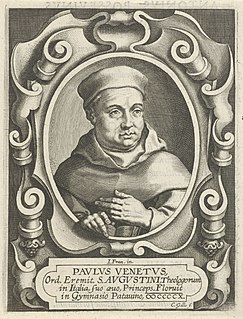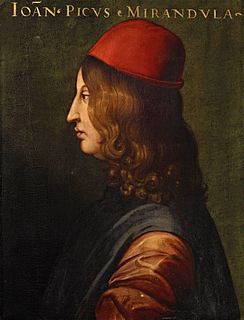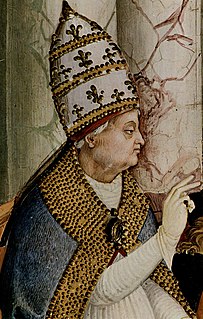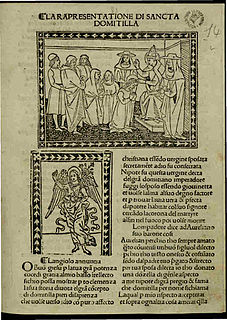 W
WBenedetto Accolti was an Italian jurist, humanist and historian.
 W
WNiccolò Albergati was an Italian Roman Catholic prelate and professed member from the Carthusians. He became a cardinal and had served as a papal diplomat to France and England (1422–23) in addition to serving as the Bishop of Bologna from 1417 until his death.
 W
WAntonio di Paolo Benivieni (1443–1502) was a Florentine physician who pioneered the use of the autopsy and many medical historians have considered him a founder of pathology.
 W
WGasparinus de Bergamo was an Italian grammarian and teacher noted for introducing a new style of epistolary Latin inspired by the works of Cicero.
 W
WFlavio Biondo was an Italian Renaissance humanist historian. He was one of the first historians to use a three-period division of history and is known as one of the first archaeologists. Born in the capital city of Forlì, in the Romagna region, Flavio was well schooled from an early age, studying under Ballistario of Cremona. During a brief stay in Milan, he discovered and transcribed the unique manuscript of Cicero's dialogue Brutus. He moved to Rome in 1433 where he began work on his writing career; he was appointed secretary to the Cancelleria under Eugene IV in 1444 and accompanied Eugene in his exile in Ferrara and Florence. After his patron's death, Flavio was employed by his papal successors, Nicholas V, Callixtus III and the humanist Pius II.
 W
WGian Francesco Poggio Bracciolini, usually referred to simply as Poggio Bracciolini, was an Italian scholar and an early Renaissance humanist. He was responsible for rediscovering and recovering many classical Latin manuscripts, mostly decaying and forgotten in German, Swiss, and French monastic libraries. His most celebrated finds are De rerum natura, the only surviving work by Lucretius, De architectura by Vitruvius, lost orations by Cicero such as Pro Sexto Roscio, Quintilian's Institutio Oratoria, Statius' Silvae, and Silius Italicus's Punica, as well as works by several minor authors such as Frontinus' De aquaeductu, Ammianus Marcellinus, Nonius Marcellus, Probus, Flavius Caper, and Eutyches.
 W
WFilippo Buonaccorsi, called Callimachus, Callimico, Bonacurarius, Caeculus, Geminianensis 2 May 1437 – 1 November 1496, was an Italian humanist, writer and diplomat active in Poland.
 W
WCristoforo Buondelmonti was an Italian Franciscan priest and traveler, and a pioneer in promoting first-hand knowledge of Greece and its antiquities throughout the Western world.
 W
WSabba da Castiglione, fra' Sabba da Castiglione or Saba da Castiglione was an Italian Renaissance humanist, writer and member of the Knights Hospitaller.
 W
WChristine de Pizan or Pisan, born Cristina da Pizzano, was a poet and author at the court of King Charles VI of France and several French dukes. Venetian by birth, Christine served as a court writer in medieval France after the death of her husband. Christine's patrons included dukes Louis I of Orleans, Philip the Bold, and John the Fearless. Her best known works include The Book of the City of Ladies and The Treasure of the City of Ladies, both written when she worked for John the Fearless of Burgundy. Her books of advice to princesses, princes, and knights remained in print until the 16th century.
 W
WFrancesco Colonna was an Italian Dominican priest and monk who was credited with the authorship of the Hypnerotomachia Poliphili by an acrostic formed by initial letters of the text.
 W
WAmbrogio Contarini was a Venetian nobleman, merchant and diplomat known for an account of his travel to Iran.
 W
WPietro Candido Decembrio (1399–1477) was an Italian humanist and author of the Renaissance, and one of those involved in the rediscovery of ancient literature.
 W
WPietro Delfino or Delfin, O.S.B. Cam., was an Italian Camaldolese monk, patristic scholar, theologian, abbot, and Superior General of his religious Order.
 W
WAntonio de Ferraris, also known by his epithet Galateo, was an Italian scholar of Greek ethnicity, academic, doctor and humanist.
 W
WMarsilio Ficino was an Italian scholar and Catholic priest who was one of the most influential humanist philosophers of the early Italian Renaissance. He was an astrologer, a reviver of Neoplatonism in touch with the major academics of his day and the first translator of Plato's complete extant works into Latin. His Florentine Academy, an attempt to revive Plato's Academy, influenced the direction and tenor of the Italian Renaissance and the development of European philosophy.
 W
WFrancesco di Giorgio Martini (1439–1501) was an Italian architect, engineer, painter, sculptor, and writer. As a painter, he belonged to the Sienese School. He was considered a visionary architectural theorist—in Nikolaus Pevsner's terms: "one of the most interesting later Quattrocento architects". As a military engineer, he executed architectural designs and sculptural projects and built almost seventy fortifications for the Federico da Montefeltro, Count of Urbino, building city walls and early examples of star-shaped fortifications.
 W
WTommaso Inghirami was a Renaissance humanist and orator. He was prefect of the Vatican Library for several years and secretary of the Fifth Lateran Council.
 W
WSaint John of Capistrano was a Franciscan friar and Catholic priest from the Italian town of Capestrano, Abruzzo. Famous as a preacher, theologian, and inquisitor, he earned himself the nickname 'the Soldier Saint' when in 1456 at age 70 he led a crusade against the invading Ottoman Empire at the siege of Belgrade with the Hungarian military commander John Hunyadi.
 W
WCristoforo Landino was an Italian humanist and an important figure of the Florentine Renaissance.
 W
WNiccolò di Bernardo dei Machiavelli was an Italian Renaissance diplomat, philosopher and writer, best known for The Prince, written in 1513. He has often been called the father of modern political philosophy and political science.
 W
WFra Luca Bartolomeo de Pacioli was an Italian mathematician, Franciscan friar, collaborator with Leonardo da Vinci, and an early contributor to the field now known as accounting. He is referred to as "The Father of Accounting and Bookkeeping" in Europe and he was the second person to publish a work on the double-entry system of book-keeping on the continent. He was also called Luca di Borgo after his birthplace, Borgo Sansepolcro, Tuscany.
 W
WPaul of Venice was a Catholic philosopher, theologian, logician and metaphysician of the Order of Saint Augustine.
 W
WMatheolus Perusinus was a professor of philosophy and medicine. He was a native of Perugia, and died at Padua.
 W
WPeter of Bergamo also called Peter of Almadura was an Italian Dominican theologian.
 W
WGiovanni Pico della Mirandola was an Italian Renaissance nobleman and philosopher. He is famed for the events of 1486, when, at the age of 23, he proposed to defend 900 theses on religion, philosophy, natural philosophy, and magic against all comers, for which he wrote the Oration on the Dignity of Man, which has been called the "Manifesto of the Renaissance", and a key text of Renaissance humanism and of what has been called the "Hermetic Reformation". He was the founder of the tradition of Christian Kabbalah, a key tenet of early modern Western esotericism. The 900 Theses was the first printed book to be universally banned by the Church.
 W
WPope Pius II, born Enea Silvio Bartolomeo Piccolomini, was head of the Catholic Church and ruler of the Papal States from 19 August 1458 to his death. He was born at Corsignano in the Sienese territory of a noble but impoverished family. His longest and most enduring work is the story of his life, the Commentaries, which is the only revealed autobiography ever to have been written by a reigning pope.
 W
WCiriaco de' Pizzicolli or Cyriacus of Ancona was a restlessly itinerant Italian humanist and antiquarian who came from a prominent family of merchants in Ancona, a port on the Adriatic. He has been called the Father of Archaeology:
 W
WAntonia Tanini Pulci was an Italian playwright whose works were published in several editions in the fifteenth and sixteenth centuries.
 W
WIppolita Maria Sforza was an Italian noblewoman, a member of the Sforza family which ruled the Duchy of Milan from 1450 until 1535. She was the first wife of Alfonso, Duke of Calabria, who later reigned as King Alfonso II of Naples.
 W
WPalla di Onofrio Strozzi was an Italian banker, politician, writer, philosopher and philologist.
 W
WAmbrogio Traversari, also referred to as Ambrose of Camaldoli, was an Italian monk and theologian who was a prime supporter of the papal cause in the 15th century. He is honored as a saint by the Camaldolese Order.
 W
WLorenzo Valla was an Italian humanist, rhetorician, educator and Catholic priest. He is best known for his textual analysis that proved that the Donation of Constantine was a forgery.
 W
WAngelo da Vallombrosa or Angelus Anachorita Vallombrosa (1455–1530) was an Italian jurist and abbot.
 W
WFrancesco Zabarella was an Italian cardinal and canonist.